Strategic Human Resource Management Proposal - HealthReach Case Study
VerifiedAdded on 2023/01/23
|9
|2379
|91
Report
AI Summary
This report presents a strategic human resource management proposal for HealthReach, a healthcare provider facing challenges such as high absenteeism, turnover rates, low job satisfaction, and a lack of employee empowerment. The proposal, developed by a human resource consultant, identifies four key components of a high-performance work system: workforce planning, employee empowerment, performance management, and improving workplace conditions. Workforce planning aims to address staffing shortages and high turnover by accurately forecasting labor demand. Employee empowerment seeks to increase employee autonomy in decision-making to boost morale and job satisfaction. Performance management introduces a Management by Objectives approach and a 360-degree feedback system to monitor and measure employee performance. Finally, improving workplace conditions focuses on creating a positive environment that supports employee well-being and reduces stress. The report provides a rationale for each component, drawing on HR theories and concepts, and analyzes the predicted attitudinal and performance outcomes, including increased employee engagement, improved job satisfaction, and enhanced patient care.
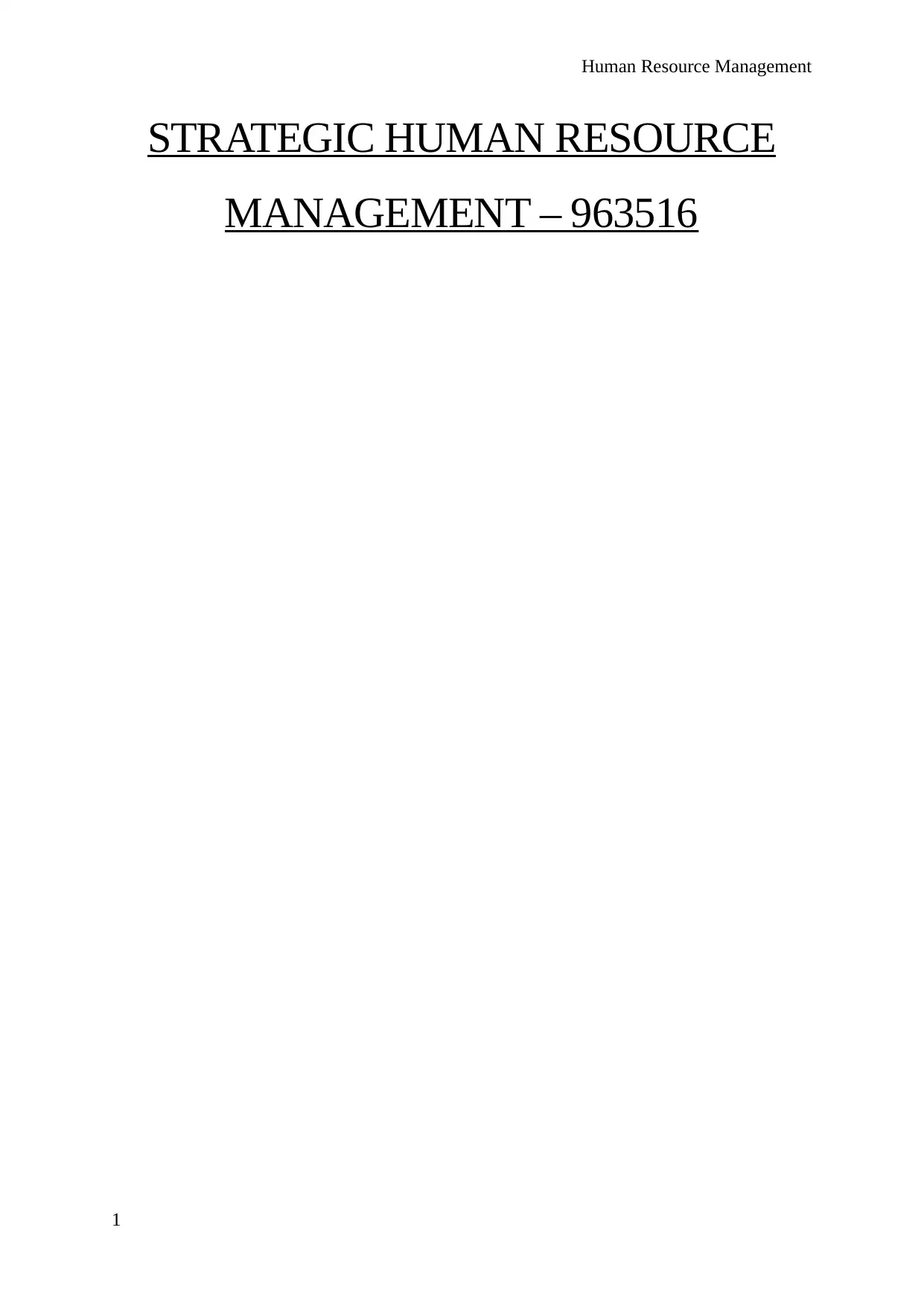
Human Resource Management
STRATEGIC HUMAN RESOURCE
MANAGEMENT – 963516
1
STRATEGIC HUMAN RESOURCE
MANAGEMENT – 963516
1
Paraphrase This Document
Need a fresh take? Get an instant paraphrase of this document with our AI Paraphraser
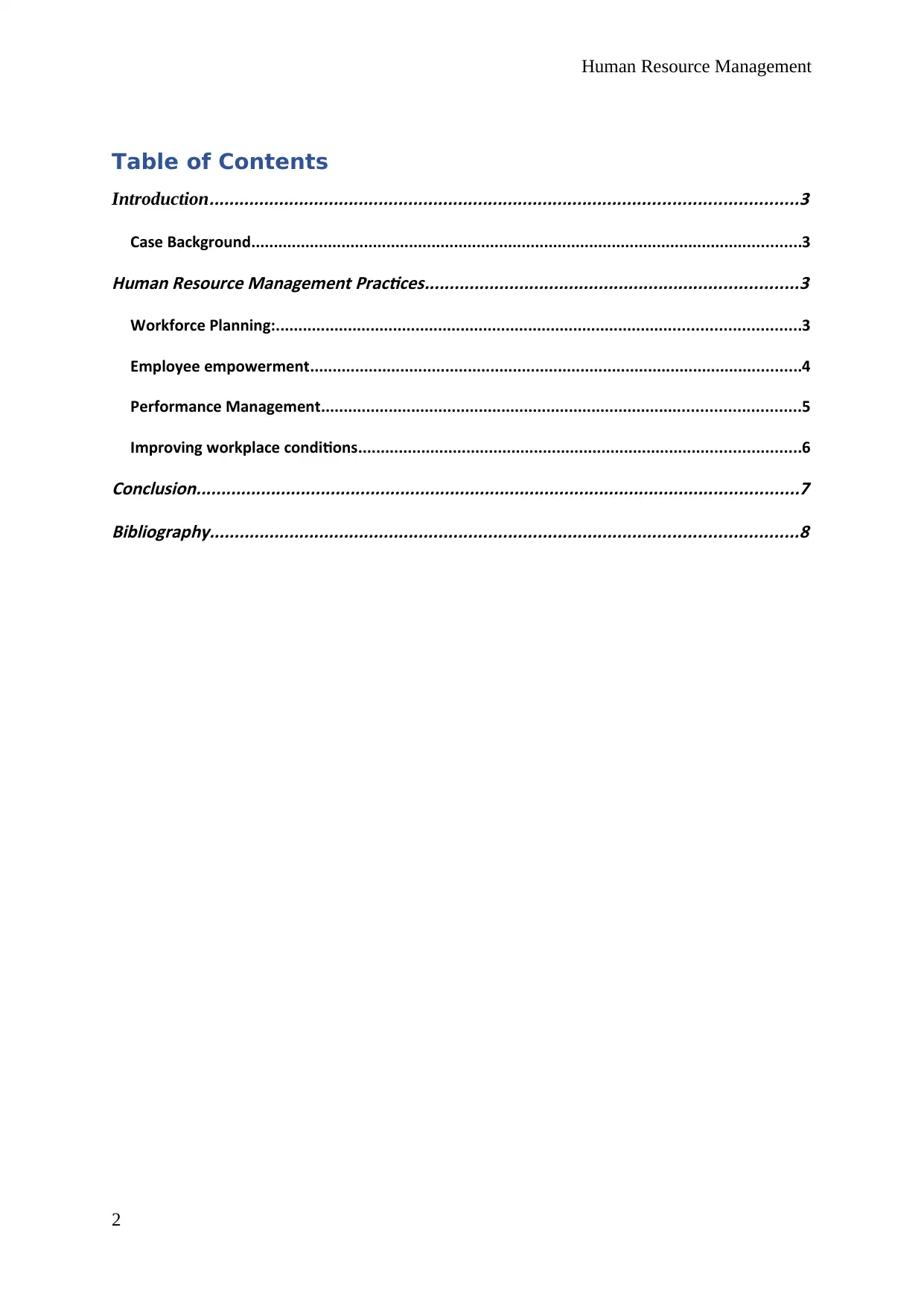
Human Resource Management
Table of Contents
Introduction
......................................................................................................................3
Case Background..........................................................................................................................3
Human Resource Management Practices...........................................................................3
Workforce Planning:....................................................................................................................3
Employee empowerment.............................................................................................................4
Performance Management..........................................................................................................5
Improving workplace conditions..................................................................................................6
Conclusion.........................................................................................................................7
Bibliography......................................................................................................................8
2
Table of Contents
Introduction
......................................................................................................................3
Case Background..........................................................................................................................3
Human Resource Management Practices...........................................................................3
Workforce Planning:....................................................................................................................3
Employee empowerment.............................................................................................................4
Performance Management..........................................................................................................5
Improving workplace conditions..................................................................................................6
Conclusion.........................................................................................................................7
Bibliography......................................................................................................................8
2
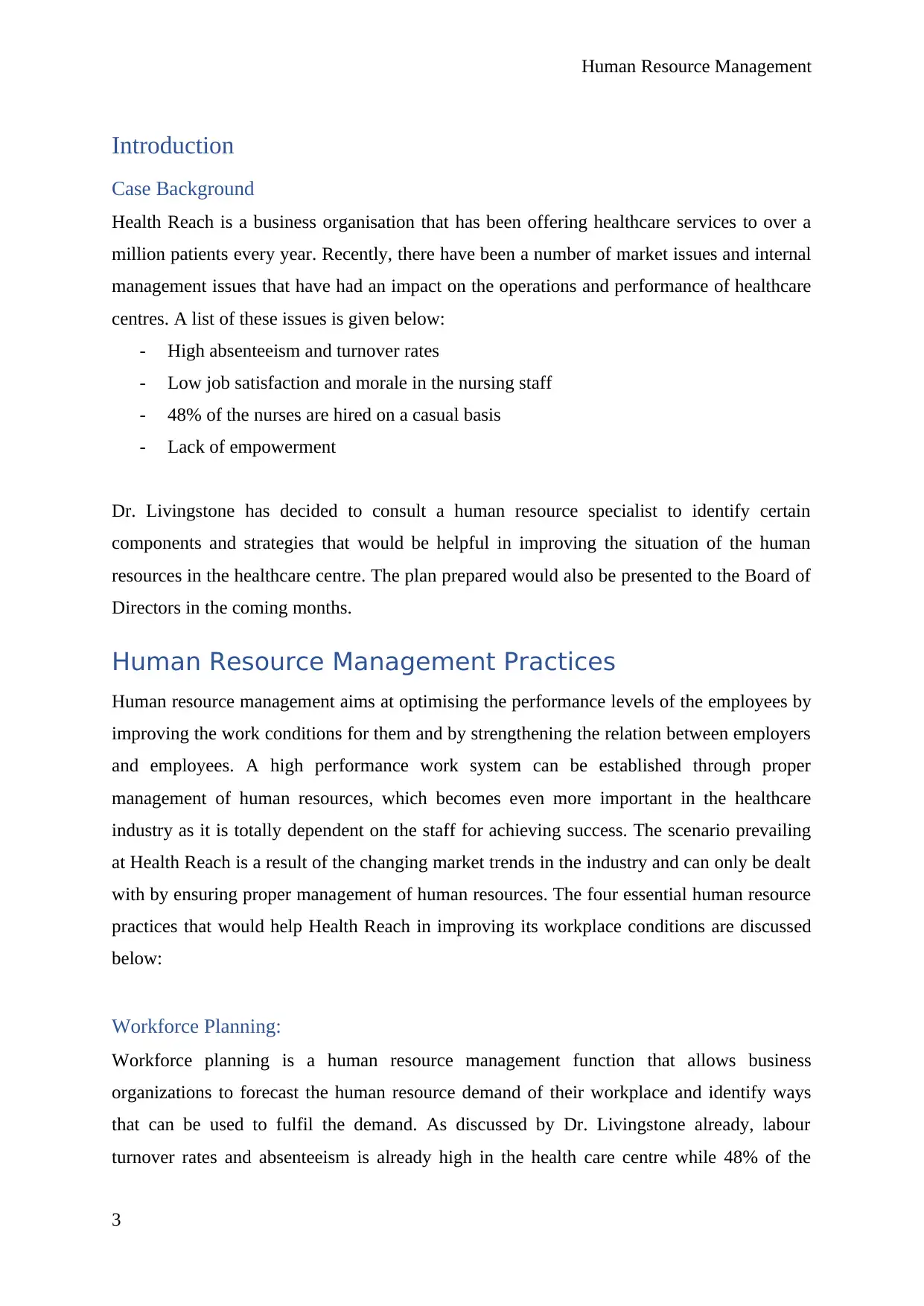
Human Resource Management
Introduction
Case Background
Health Reach is a business organisation that has been offering healthcare services to over a
million patients every year. Recently, there have been a number of market issues and internal
management issues that have had an impact on the operations and performance of healthcare
centres. A list of these issues is given below:
- High absenteeism and turnover rates
- Low job satisfaction and morale in the nursing staff
- 48% of the nurses are hired on a casual basis
- Lack of empowerment
Dr. Livingstone has decided to consult a human resource specialist to identify certain
components and strategies that would be helpful in improving the situation of the human
resources in the healthcare centre. The plan prepared would also be presented to the Board of
Directors in the coming months.
Human Resource Management Practices
Human resource management aims at optimising the performance levels of the employees by
improving the work conditions for them and by strengthening the relation between employers
and employees. A high performance work system can be established through proper
management of human resources, which becomes even more important in the healthcare
industry as it is totally dependent on the staff for achieving success. The scenario prevailing
at Health Reach is a result of the changing market trends in the industry and can only be dealt
with by ensuring proper management of human resources. The four essential human resource
practices that would help Health Reach in improving its workplace conditions are discussed
below:
Workforce Planning:
Workforce planning is a human resource management function that allows business
organizations to forecast the human resource demand of their workplace and identify ways
that can be used to fulfil the demand. As discussed by Dr. Livingstone already, labour
turnover rates and absenteeism is already high in the health care centre while 48% of the
3
Introduction
Case Background
Health Reach is a business organisation that has been offering healthcare services to over a
million patients every year. Recently, there have been a number of market issues and internal
management issues that have had an impact on the operations and performance of healthcare
centres. A list of these issues is given below:
- High absenteeism and turnover rates
- Low job satisfaction and morale in the nursing staff
- 48% of the nurses are hired on a casual basis
- Lack of empowerment
Dr. Livingstone has decided to consult a human resource specialist to identify certain
components and strategies that would be helpful in improving the situation of the human
resources in the healthcare centre. The plan prepared would also be presented to the Board of
Directors in the coming months.
Human Resource Management Practices
Human resource management aims at optimising the performance levels of the employees by
improving the work conditions for them and by strengthening the relation between employers
and employees. A high performance work system can be established through proper
management of human resources, which becomes even more important in the healthcare
industry as it is totally dependent on the staff for achieving success. The scenario prevailing
at Health Reach is a result of the changing market trends in the industry and can only be dealt
with by ensuring proper management of human resources. The four essential human resource
practices that would help Health Reach in improving its workplace conditions are discussed
below:
Workforce Planning:
Workforce planning is a human resource management function that allows business
organizations to forecast the human resource demand of their workplace and identify ways
that can be used to fulfil the demand. As discussed by Dr. Livingstone already, labour
turnover rates and absenteeism is already high in the health care centre while 48% of the
3
⊘ This is a preview!⊘
Do you want full access?
Subscribe today to unlock all pages.

Trusted by 1+ million students worldwide
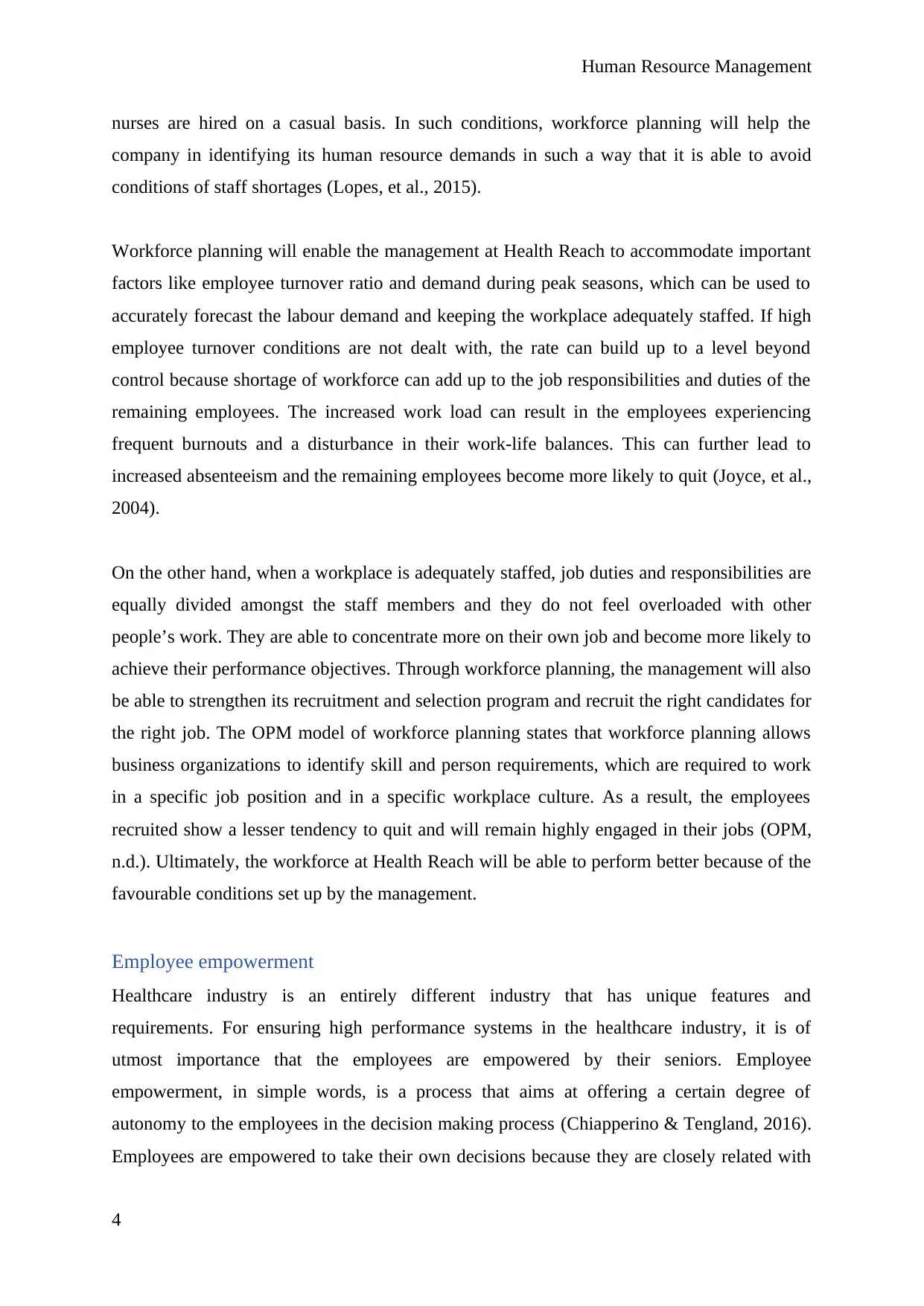
Human Resource Management
nurses are hired on a casual basis. In such conditions, workforce planning will help the
company in identifying its human resource demands in such a way that it is able to avoid
conditions of staff shortages (Lopes, et al., 2015).
Workforce planning will enable the management at Health Reach to accommodate important
factors like employee turnover ratio and demand during peak seasons, which can be used to
accurately forecast the labour demand and keeping the workplace adequately staffed. If high
employee turnover conditions are not dealt with, the rate can build up to a level beyond
control because shortage of workforce can add up to the job responsibilities and duties of the
remaining employees. The increased work load can result in the employees experiencing
frequent burnouts and a disturbance in their work-life balances. This can further lead to
increased absenteeism and the remaining employees become more likely to quit (Joyce, et al.,
2004).
On the other hand, when a workplace is adequately staffed, job duties and responsibilities are
equally divided amongst the staff members and they do not feel overloaded with other
people’s work. They are able to concentrate more on their own job and become more likely to
achieve their performance objectives. Through workforce planning, the management will also
be able to strengthen its recruitment and selection program and recruit the right candidates for
the right job. The OPM model of workforce planning states that workforce planning allows
business organizations to identify skill and person requirements, which are required to work
in a specific job position and in a specific workplace culture. As a result, the employees
recruited show a lesser tendency to quit and will remain highly engaged in their jobs (OPM,
n.d.). Ultimately, the workforce at Health Reach will be able to perform better because of the
favourable conditions set up by the management.
Employee empowerment
Healthcare industry is an entirely different industry that has unique features and
requirements. For ensuring high performance systems in the healthcare industry, it is of
utmost importance that the employees are empowered by their seniors. Employee
empowerment, in simple words, is a process that aims at offering a certain degree of
autonomy to the employees in the decision making process (Chiapperino & Tengland, 2016).
Employees are empowered to take their own decisions because they are closely related with
4
nurses are hired on a casual basis. In such conditions, workforce planning will help the
company in identifying its human resource demands in such a way that it is able to avoid
conditions of staff shortages (Lopes, et al., 2015).
Workforce planning will enable the management at Health Reach to accommodate important
factors like employee turnover ratio and demand during peak seasons, which can be used to
accurately forecast the labour demand and keeping the workplace adequately staffed. If high
employee turnover conditions are not dealt with, the rate can build up to a level beyond
control because shortage of workforce can add up to the job responsibilities and duties of the
remaining employees. The increased work load can result in the employees experiencing
frequent burnouts and a disturbance in their work-life balances. This can further lead to
increased absenteeism and the remaining employees become more likely to quit (Joyce, et al.,
2004).
On the other hand, when a workplace is adequately staffed, job duties and responsibilities are
equally divided amongst the staff members and they do not feel overloaded with other
people’s work. They are able to concentrate more on their own job and become more likely to
achieve their performance objectives. Through workforce planning, the management will also
be able to strengthen its recruitment and selection program and recruit the right candidates for
the right job. The OPM model of workforce planning states that workforce planning allows
business organizations to identify skill and person requirements, which are required to work
in a specific job position and in a specific workplace culture. As a result, the employees
recruited show a lesser tendency to quit and will remain highly engaged in their jobs (OPM,
n.d.). Ultimately, the workforce at Health Reach will be able to perform better because of the
favourable conditions set up by the management.
Employee empowerment
Healthcare industry is an entirely different industry that has unique features and
requirements. For ensuring high performance systems in the healthcare industry, it is of
utmost importance that the employees are empowered by their seniors. Employee
empowerment, in simple words, is a process that aims at offering a certain degree of
autonomy to the employees in the decision making process (Chiapperino & Tengland, 2016).
Employees are empowered to take their own decisions because they are closely related with
4
Paraphrase This Document
Need a fresh take? Get an instant paraphrase of this document with our AI Paraphraser
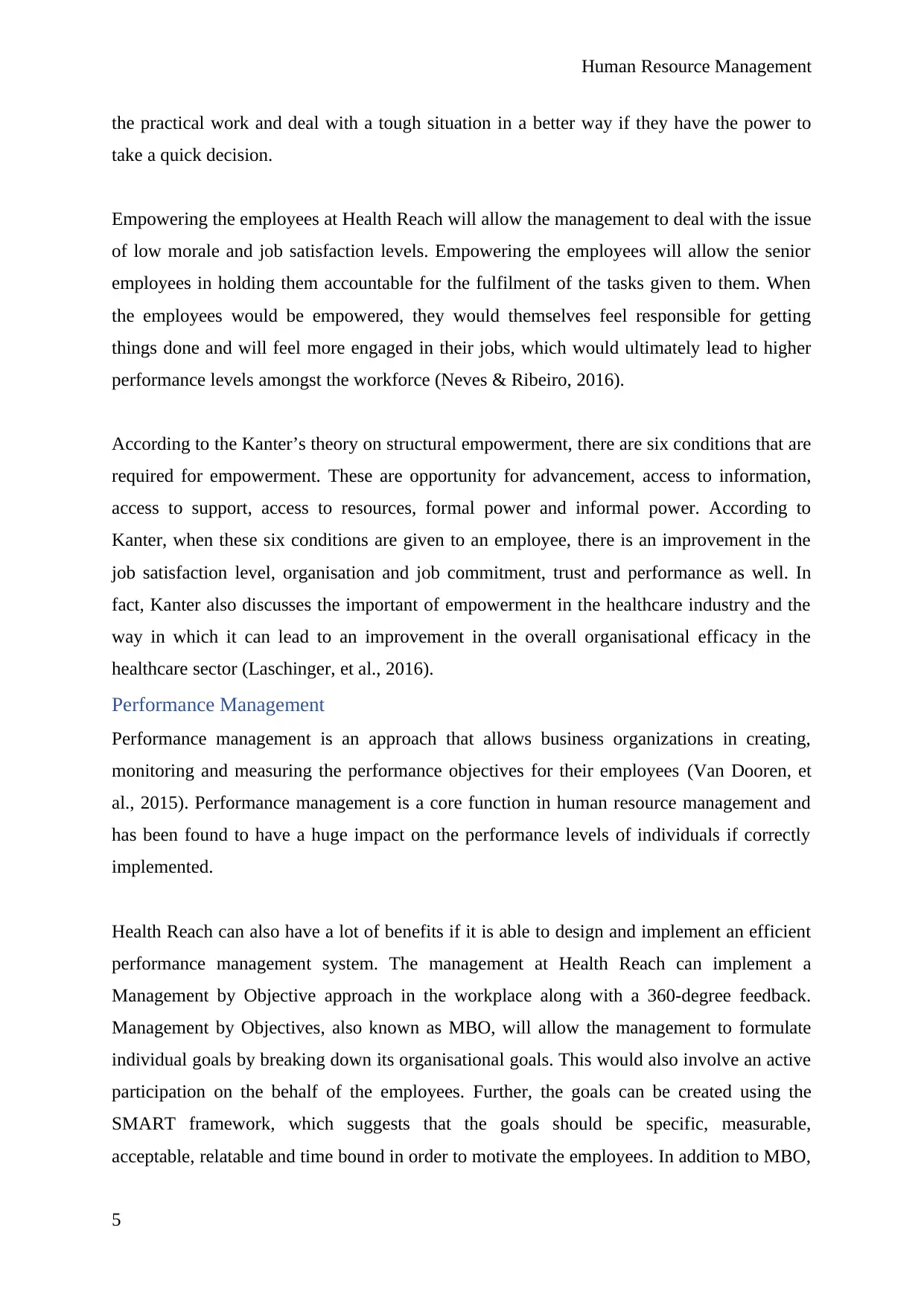
Human Resource Management
the practical work and deal with a tough situation in a better way if they have the power to
take a quick decision.
Empowering the employees at Health Reach will allow the management to deal with the issue
of low morale and job satisfaction levels. Empowering the employees will allow the senior
employees in holding them accountable for the fulfilment of the tasks given to them. When
the employees would be empowered, they would themselves feel responsible for getting
things done and will feel more engaged in their jobs, which would ultimately lead to higher
performance levels amongst the workforce (Neves & Ribeiro, 2016).
According to the Kanter’s theory on structural empowerment, there are six conditions that are
required for empowerment. These are opportunity for advancement, access to information,
access to support, access to resources, formal power and informal power. According to
Kanter, when these six conditions are given to an employee, there is an improvement in the
job satisfaction level, organisation and job commitment, trust and performance as well. In
fact, Kanter also discusses the important of empowerment in the healthcare industry and the
way in which it can lead to an improvement in the overall organisational efficacy in the
healthcare sector (Laschinger, et al., 2016).
Performance Management
Performance management is an approach that allows business organizations in creating,
monitoring and measuring the performance objectives for their employees (Van Dooren, et
al., 2015). Performance management is a core function in human resource management and
has been found to have a huge impact on the performance levels of individuals if correctly
implemented.
Health Reach can also have a lot of benefits if it is able to design and implement an efficient
performance management system. The management at Health Reach can implement a
Management by Objective approach in the workplace along with a 360-degree feedback.
Management by Objectives, also known as MBO, will allow the management to formulate
individual goals by breaking down its organisational goals. This would also involve an active
participation on the behalf of the employees. Further, the goals can be created using the
SMART framework, which suggests that the goals should be specific, measurable,
acceptable, relatable and time bound in order to motivate the employees. In addition to MBO,
5
the practical work and deal with a tough situation in a better way if they have the power to
take a quick decision.
Empowering the employees at Health Reach will allow the management to deal with the issue
of low morale and job satisfaction levels. Empowering the employees will allow the senior
employees in holding them accountable for the fulfilment of the tasks given to them. When
the employees would be empowered, they would themselves feel responsible for getting
things done and will feel more engaged in their jobs, which would ultimately lead to higher
performance levels amongst the workforce (Neves & Ribeiro, 2016).
According to the Kanter’s theory on structural empowerment, there are six conditions that are
required for empowerment. These are opportunity for advancement, access to information,
access to support, access to resources, formal power and informal power. According to
Kanter, when these six conditions are given to an employee, there is an improvement in the
job satisfaction level, organisation and job commitment, trust and performance as well. In
fact, Kanter also discusses the important of empowerment in the healthcare industry and the
way in which it can lead to an improvement in the overall organisational efficacy in the
healthcare sector (Laschinger, et al., 2016).
Performance Management
Performance management is an approach that allows business organizations in creating,
monitoring and measuring the performance objectives for their employees (Van Dooren, et
al., 2015). Performance management is a core function in human resource management and
has been found to have a huge impact on the performance levels of individuals if correctly
implemented.
Health Reach can also have a lot of benefits if it is able to design and implement an efficient
performance management system. The management at Health Reach can implement a
Management by Objective approach in the workplace along with a 360-degree feedback.
Management by Objectives, also known as MBO, will allow the management to formulate
individual goals by breaking down its organisational goals. This would also involve an active
participation on the behalf of the employees. Further, the goals can be created using the
SMART framework, which suggests that the goals should be specific, measurable,
acceptable, relatable and time bound in order to motivate the employees. In addition to MBO,
5
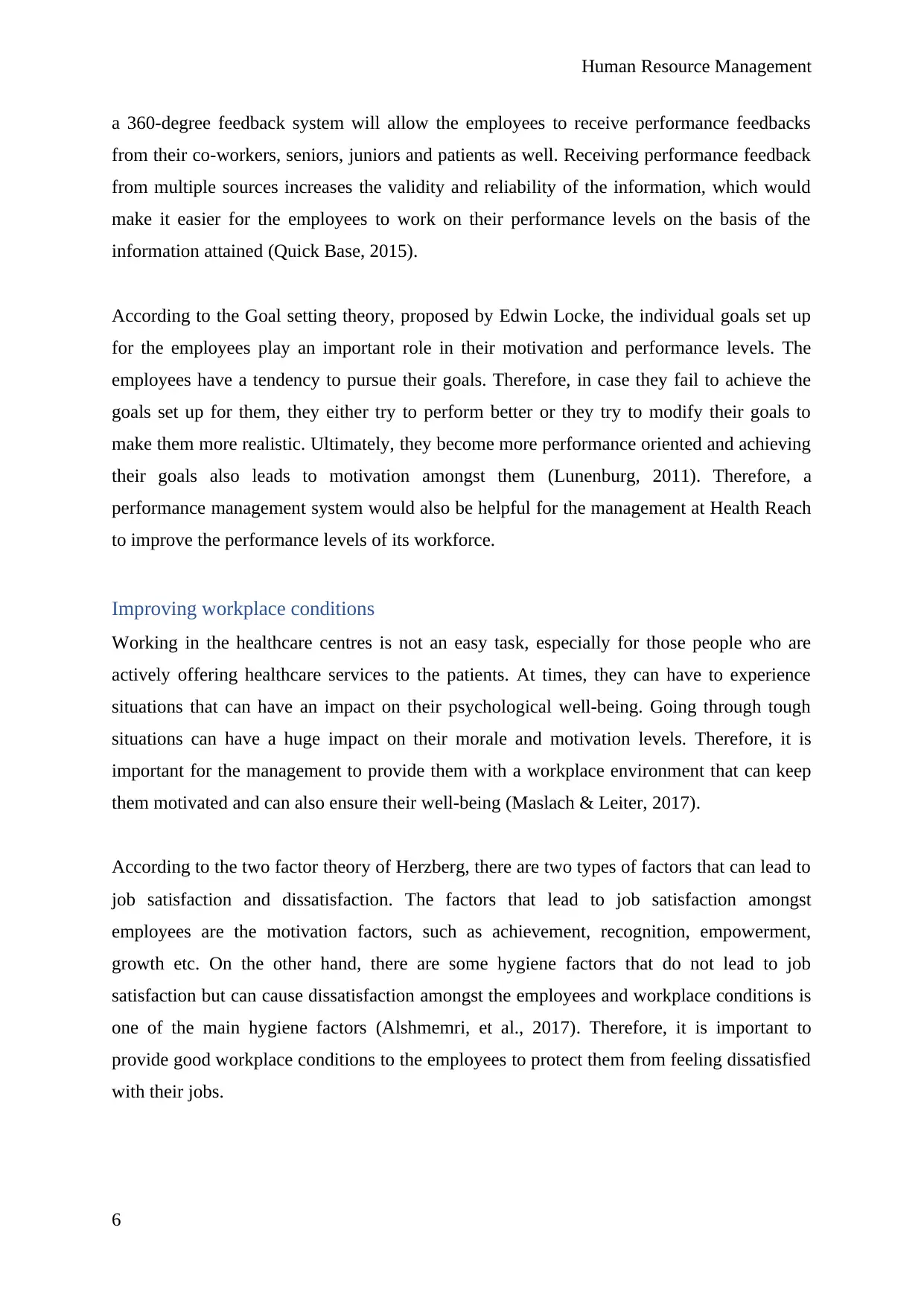
Human Resource Management
a 360-degree feedback system will allow the employees to receive performance feedbacks
from their co-workers, seniors, juniors and patients as well. Receiving performance feedback
from multiple sources increases the validity and reliability of the information, which would
make it easier for the employees to work on their performance levels on the basis of the
information attained (Quick Base, 2015).
According to the Goal setting theory, proposed by Edwin Locke, the individual goals set up
for the employees play an important role in their motivation and performance levels. The
employees have a tendency to pursue their goals. Therefore, in case they fail to achieve the
goals set up for them, they either try to perform better or they try to modify their goals to
make them more realistic. Ultimately, they become more performance oriented and achieving
their goals also leads to motivation amongst them (Lunenburg, 2011). Therefore, a
performance management system would also be helpful for the management at Health Reach
to improve the performance levels of its workforce.
Improving workplace conditions
Working in the healthcare centres is not an easy task, especially for those people who are
actively offering healthcare services to the patients. At times, they can have to experience
situations that can have an impact on their psychological well-being. Going through tough
situations can have a huge impact on their morale and motivation levels. Therefore, it is
important for the management to provide them with a workplace environment that can keep
them motivated and can also ensure their well-being (Maslach & Leiter, 2017).
According to the two factor theory of Herzberg, there are two types of factors that can lead to
job satisfaction and dissatisfaction. The factors that lead to job satisfaction amongst
employees are the motivation factors, such as achievement, recognition, empowerment,
growth etc. On the other hand, there are some hygiene factors that do not lead to job
satisfaction but can cause dissatisfaction amongst the employees and workplace conditions is
one of the main hygiene factors (Alshmemri, et al., 2017). Therefore, it is important to
provide good workplace conditions to the employees to protect them from feeling dissatisfied
with their jobs.
6
a 360-degree feedback system will allow the employees to receive performance feedbacks
from their co-workers, seniors, juniors and patients as well. Receiving performance feedback
from multiple sources increases the validity and reliability of the information, which would
make it easier for the employees to work on their performance levels on the basis of the
information attained (Quick Base, 2015).
According to the Goal setting theory, proposed by Edwin Locke, the individual goals set up
for the employees play an important role in their motivation and performance levels. The
employees have a tendency to pursue their goals. Therefore, in case they fail to achieve the
goals set up for them, they either try to perform better or they try to modify their goals to
make them more realistic. Ultimately, they become more performance oriented and achieving
their goals also leads to motivation amongst them (Lunenburg, 2011). Therefore, a
performance management system would also be helpful for the management at Health Reach
to improve the performance levels of its workforce.
Improving workplace conditions
Working in the healthcare centres is not an easy task, especially for those people who are
actively offering healthcare services to the patients. At times, they can have to experience
situations that can have an impact on their psychological well-being. Going through tough
situations can have a huge impact on their morale and motivation levels. Therefore, it is
important for the management to provide them with a workplace environment that can keep
them motivated and can also ensure their well-being (Maslach & Leiter, 2017).
According to the two factor theory of Herzberg, there are two types of factors that can lead to
job satisfaction and dissatisfaction. The factors that lead to job satisfaction amongst
employees are the motivation factors, such as achievement, recognition, empowerment,
growth etc. On the other hand, there are some hygiene factors that do not lead to job
satisfaction but can cause dissatisfaction amongst the employees and workplace conditions is
one of the main hygiene factors (Alshmemri, et al., 2017). Therefore, it is important to
provide good workplace conditions to the employees to protect them from feeling dissatisfied
with their jobs.
6
⊘ This is a preview!⊘
Do you want full access?
Subscribe today to unlock all pages.

Trusted by 1+ million students worldwide
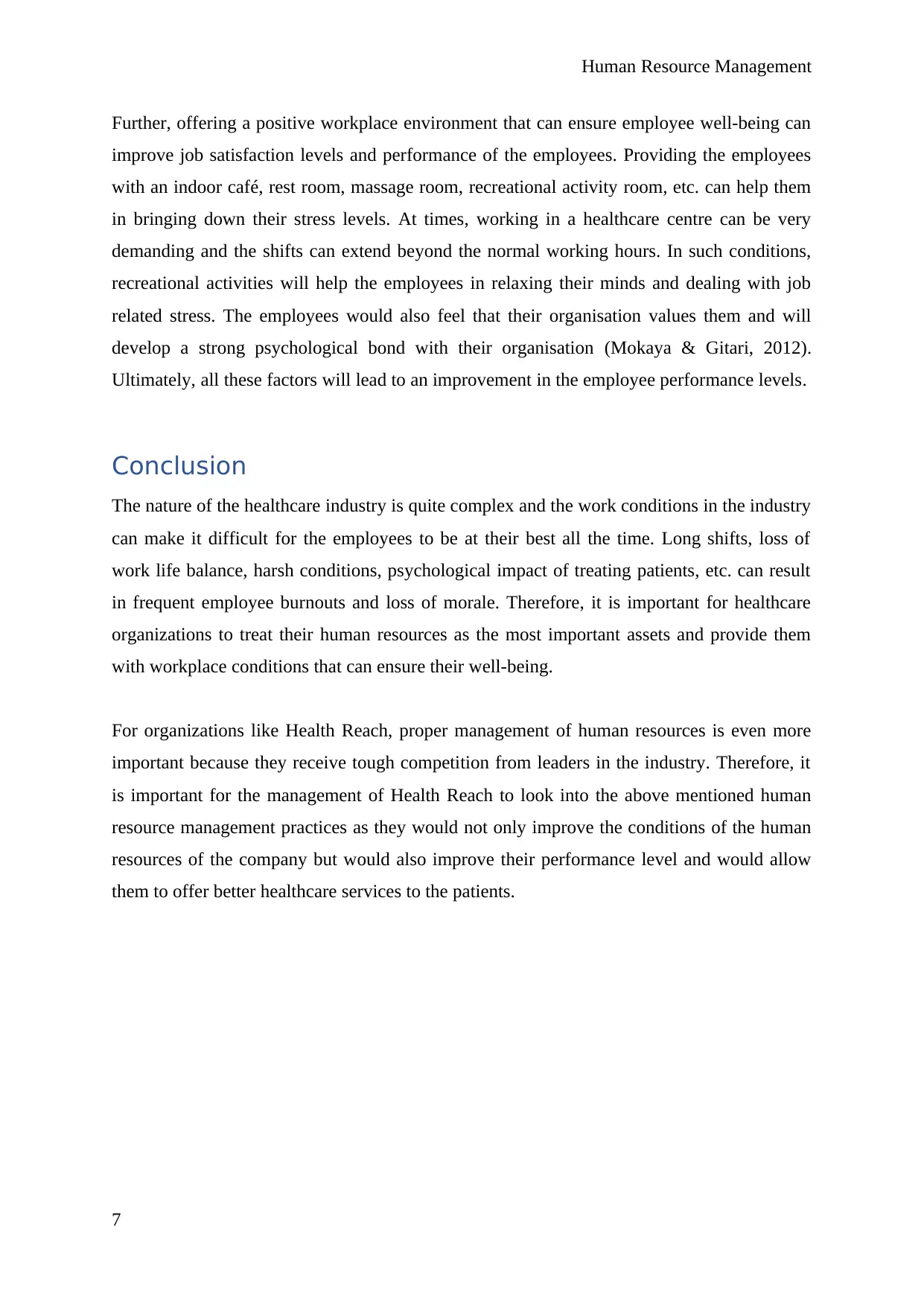
Human Resource Management
Further, offering a positive workplace environment that can ensure employee well-being can
improve job satisfaction levels and performance of the employees. Providing the employees
with an indoor café, rest room, massage room, recreational activity room, etc. can help them
in bringing down their stress levels. At times, working in a healthcare centre can be very
demanding and the shifts can extend beyond the normal working hours. In such conditions,
recreational activities will help the employees in relaxing their minds and dealing with job
related stress. The employees would also feel that their organisation values them and will
develop a strong psychological bond with their organisation (Mokaya & Gitari, 2012).
Ultimately, all these factors will lead to an improvement in the employee performance levels.
Conclusion
The nature of the healthcare industry is quite complex and the work conditions in the industry
can make it difficult for the employees to be at their best all the time. Long shifts, loss of
work life balance, harsh conditions, psychological impact of treating patients, etc. can result
in frequent employee burnouts and loss of morale. Therefore, it is important for healthcare
organizations to treat their human resources as the most important assets and provide them
with workplace conditions that can ensure their well-being.
For organizations like Health Reach, proper management of human resources is even more
important because they receive tough competition from leaders in the industry. Therefore, it
is important for the management of Health Reach to look into the above mentioned human
resource management practices as they would not only improve the conditions of the human
resources of the company but would also improve their performance level and would allow
them to offer better healthcare services to the patients.
7
Further, offering a positive workplace environment that can ensure employee well-being can
improve job satisfaction levels and performance of the employees. Providing the employees
with an indoor café, rest room, massage room, recreational activity room, etc. can help them
in bringing down their stress levels. At times, working in a healthcare centre can be very
demanding and the shifts can extend beyond the normal working hours. In such conditions,
recreational activities will help the employees in relaxing their minds and dealing with job
related stress. The employees would also feel that their organisation values them and will
develop a strong psychological bond with their organisation (Mokaya & Gitari, 2012).
Ultimately, all these factors will lead to an improvement in the employee performance levels.
Conclusion
The nature of the healthcare industry is quite complex and the work conditions in the industry
can make it difficult for the employees to be at their best all the time. Long shifts, loss of
work life balance, harsh conditions, psychological impact of treating patients, etc. can result
in frequent employee burnouts and loss of morale. Therefore, it is important for healthcare
organizations to treat their human resources as the most important assets and provide them
with workplace conditions that can ensure their well-being.
For organizations like Health Reach, proper management of human resources is even more
important because they receive tough competition from leaders in the industry. Therefore, it
is important for the management of Health Reach to look into the above mentioned human
resource management practices as they would not only improve the conditions of the human
resources of the company but would also improve their performance level and would allow
them to offer better healthcare services to the patients.
7
Paraphrase This Document
Need a fresh take? Get an instant paraphrase of this document with our AI Paraphraser
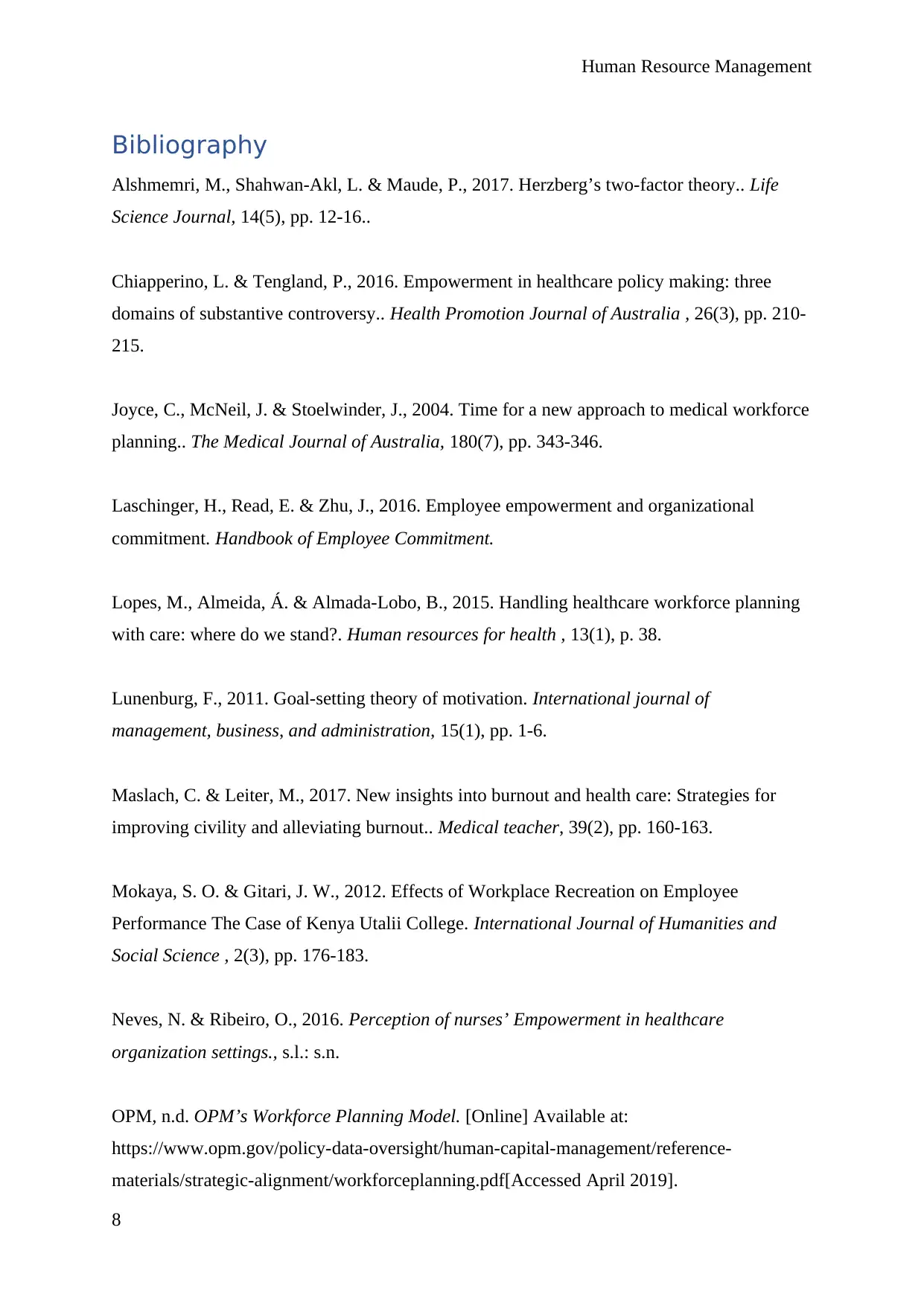
Human Resource Management
Bibliography
Alshmemri, M., Shahwan-Akl, L. & Maude, P., 2017. Herzberg’s two-factor theory.. Life
Science Journal, 14(5), pp. 12-16..
Chiapperino, L. & Tengland, P., 2016. Empowerment in healthcare policy making: three
domains of substantive controversy.. Health Promotion Journal of Australia , 26(3), pp. 210-
215.
Joyce, C., McNeil, J. & Stoelwinder, J., 2004. Time for a new approach to medical workforce
planning.. The Medical Journal of Australia, 180(7), pp. 343-346.
Laschinger, H., Read, E. & Zhu, J., 2016. Employee empowerment and organizational
commitment. Handbook of Employee Commitment.
Lopes, M., Almeida, Á. & Almada-Lobo, B., 2015. Handling healthcare workforce planning
with care: where do we stand?. Human resources for health , 13(1), p. 38.
Lunenburg, F., 2011. Goal-setting theory of motivation. International journal of
management, business, and administration, 15(1), pp. 1-6.
Maslach, C. & Leiter, M., 2017. New insights into burnout and health care: Strategies for
improving civility and alleviating burnout.. Medical teacher, 39(2), pp. 160-163.
Mokaya, S. O. & Gitari, J. W., 2012. Effects of Workplace Recreation on Employee
Performance The Case of Kenya Utalii College. International Journal of Humanities and
Social Science , 2(3), pp. 176-183.
Neves, N. & Ribeiro, O., 2016. Perception of nurses’ Empowerment in healthcare
organization settings., s.l.: s.n.
OPM, n.d. OPM’s Workforce Planning Model. [Online] Available at:
https://www.opm.gov/policy-data-oversight/human-capital-management/reference-
materials/strategic-alignment/workforceplanning.pdf[Accessed April 2019].
8
Bibliography
Alshmemri, M., Shahwan-Akl, L. & Maude, P., 2017. Herzberg’s two-factor theory.. Life
Science Journal, 14(5), pp. 12-16..
Chiapperino, L. & Tengland, P., 2016. Empowerment in healthcare policy making: three
domains of substantive controversy.. Health Promotion Journal of Australia , 26(3), pp. 210-
215.
Joyce, C., McNeil, J. & Stoelwinder, J., 2004. Time for a new approach to medical workforce
planning.. The Medical Journal of Australia, 180(7), pp. 343-346.
Laschinger, H., Read, E. & Zhu, J., 2016. Employee empowerment and organizational
commitment. Handbook of Employee Commitment.
Lopes, M., Almeida, Á. & Almada-Lobo, B., 2015. Handling healthcare workforce planning
with care: where do we stand?. Human resources for health , 13(1), p. 38.
Lunenburg, F., 2011. Goal-setting theory of motivation. International journal of
management, business, and administration, 15(1), pp. 1-6.
Maslach, C. & Leiter, M., 2017. New insights into burnout and health care: Strategies for
improving civility and alleviating burnout.. Medical teacher, 39(2), pp. 160-163.
Mokaya, S. O. & Gitari, J. W., 2012. Effects of Workplace Recreation on Employee
Performance The Case of Kenya Utalii College. International Journal of Humanities and
Social Science , 2(3), pp. 176-183.
Neves, N. & Ribeiro, O., 2016. Perception of nurses’ Empowerment in healthcare
organization settings., s.l.: s.n.
OPM, n.d. OPM’s Workforce Planning Model. [Online] Available at:
https://www.opm.gov/policy-data-oversight/human-capital-management/reference-
materials/strategic-alignment/workforceplanning.pdf[Accessed April 2019].
8
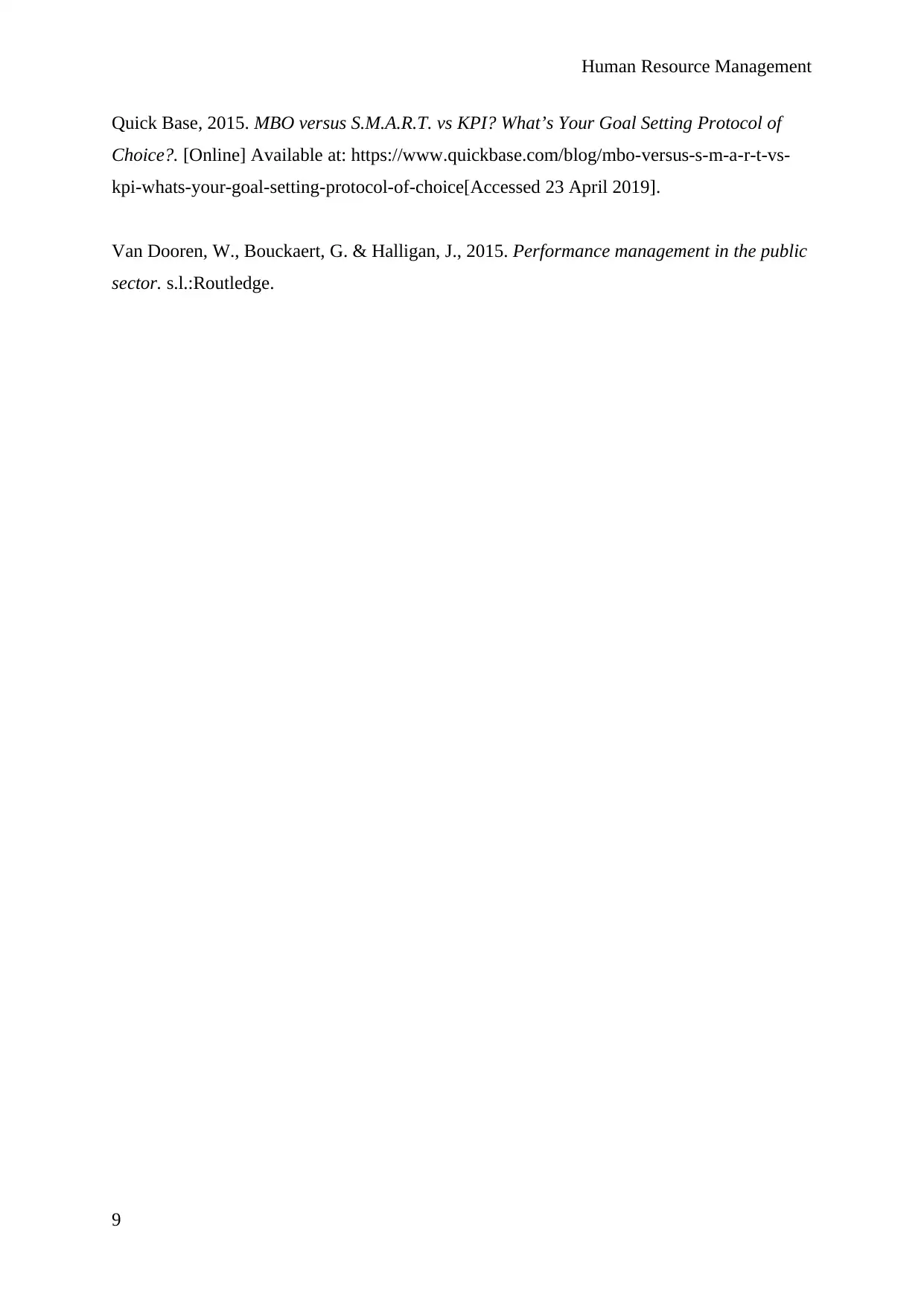
Human Resource Management
Quick Base, 2015. MBO versus S.M.A.R.T. vs KPI? What’s Your Goal Setting Protocol of
Choice?. [Online] Available at: https://www.quickbase.com/blog/mbo-versus-s-m-a-r-t-vs-
kpi-whats-your-goal-setting-protocol-of-choice[Accessed 23 April 2019].
Van Dooren, W., Bouckaert, G. & Halligan, J., 2015. Performance management in the public
sector. s.l.:Routledge.
9
Quick Base, 2015. MBO versus S.M.A.R.T. vs KPI? What’s Your Goal Setting Protocol of
Choice?. [Online] Available at: https://www.quickbase.com/blog/mbo-versus-s-m-a-r-t-vs-
kpi-whats-your-goal-setting-protocol-of-choice[Accessed 23 April 2019].
Van Dooren, W., Bouckaert, G. & Halligan, J., 2015. Performance management in the public
sector. s.l.:Routledge.
9
⊘ This is a preview!⊘
Do you want full access?
Subscribe today to unlock all pages.

Trusted by 1+ million students worldwide
1 out of 9
Related Documents
Your All-in-One AI-Powered Toolkit for Academic Success.
+13062052269
info@desklib.com
Available 24*7 on WhatsApp / Email
![[object Object]](/_next/static/media/star-bottom.7253800d.svg)
Unlock your academic potential
Copyright © 2020–2025 A2Z Services. All Rights Reserved. Developed and managed by ZUCOL.





